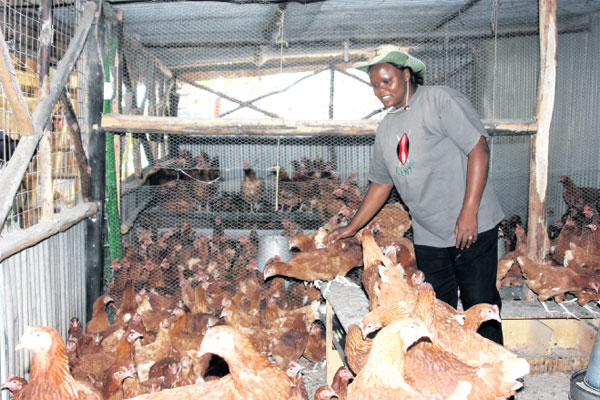Beatrice Kirui’s farm in Kiamunyi, Nakuru, hosts 3,000 chickens, 30 rabbits, three cows and two goats. To begin with, the chicken pen built from iron sheets and wood is one-storey, with each unit holding 1,500 chickens.
From this simple structure, she collects between 70 and 80 trays of eggs every day, which she sells at Sh310 each, most of them to wholesalers, hoteliers and bakeries around Nakuru.
Similarly, the rabbit pen is one-storey, though of smaller size, with each unit hosting 15 rabbits. In addition, the compound has space for a servant’s quarter, a brooding house and a kitchen that serves the farm workers.
Kirui works with a seed company in Uasin Gishu and only visits her farm at the weekend.
She has employed four workers, two to take care of the poultry, another the dairy cows, rabbits and goats while the other works as the general manager, overseeing the running of the farm, including monitoring the sales.
I earn Sh. 60,000 from my IT job and Sh. 150,000 from chicken farming
“I know what my chickens and cows produce weekly, thus, I am able to estimate my earnings. I keep track of everything that happens on the farm through the phone,” she says, adding that for a farmer in her situation, it is also important to trust her employees.
Her passion for farming started three years ago when she joined a women’s merry-go-round group in Kiamunyi estate located along the Nakuru-Kabarak Road.
From the Sh30,000 she was given by members, she started the poultry business and, thereafter, bought cows. “I put up a structure and bought 100 chicks. It is from this group that my brood has expanded to 3,000,” she says.
“My friends, some who also have quarter acres, thought that the land was too small for one to engage in any meaningful agribusiness, but I have proved that you can do as many farming projects as possible on such a farm.”
The land earns her over Sh650,000 a month, with most of the money coming from her layers. She spends about Sh60,000 on salaries a month while chicken feeds costs her Sh100,000.
Everything on her farm brings in cash, including chicken waste, which she sells as manure at Sh700 for a 90kg bag, besides using it to grow crops.
The three cows, two Friesian and one Ayrshire, produce 50 litres of milk daily that she sells at Sh35 a litre. The cows have also saved her at least Sh6,000 a month, which she would be using on fuel as she generates biogas for cooking and lighting her home.
“My son asked me to keep the rabbits for him because his friends were doing the same.” She sells the rabbits for Sh500 to Sh700 each depending on the size. Many of those who buy are fellow farmers. One of her dairy goats will soon have a kid and start producing milk, which will earn her more money.
Five members of her chama have since followed in her footsteps and are keeping between 100 and 500 layers on their quarter acres with plans to diversify.
Egerton University lecturer Prof Paul Kimurto describes the farm as a “demonstration of how Kenyans should effectively utilise their small pieces of land to earn a decent a living”.
“Many people believe farming requires a huge land. On a quarter-acre, you can do a lot and earn as much as someone who has five acres,”’ says Prof Kimurto, a crop and soil scientist at Egerton University.
Prof Kimurto notes that integrated farming is the way to go as land becomes scarce due to rapid population growth.
He challenges anyone who owns a plot in an urban area to see it as a farm, rather than just a residential place, and focus on how to make money.
Kirui has no agricultural background save for the fact that she works for a seed company as a sales manager. But as you watch her test if her chicken would lay eggs, one would mistake her for a livestock expert.
“If I put three fingers in the hen’s cervix and they fit, then it means that the bird will finally lay eggs. I have to do this to determine how many of my chicken would lay eggs.”
She says she loves learning on the job, which is why she preferred starting on the common cow breed rather than the hybrids.
“It makes no sense to invest so much while you have little experience. Experience is surely the best teacher.” One of her major challenge is high cost of chickens and dairy feeds.
“Some of the feeds are also of poor quality, I recently bought chicken feeds from a supplier and my birds produced eggs with weak shells and white yolk. I suffered losses.”
She advises poultry farmers to vaccine their chicken as recommended and watch out for diseases such as fowl pox. Most Profitable Farming in Kenya.









There is plenty of ideal land suitable for irrigation along the river tana… Ngao Location in Garesen Constituency
Am looking for a partner to work on this project which pays handsomely
0724582740
This is the way to go as per the current rate of unemployment and state of economy
Wow, this is great. I know Beatrice Kirui, with whom we worked in Kitale many years back. I have one and a half acres of land in Likuyani near Soy and I would like to initiate such a project. Can I get technical assistance?
Am a Kenyan living in Uganda and I’ve passion in rearing layers I don’t have any experience pliz help me